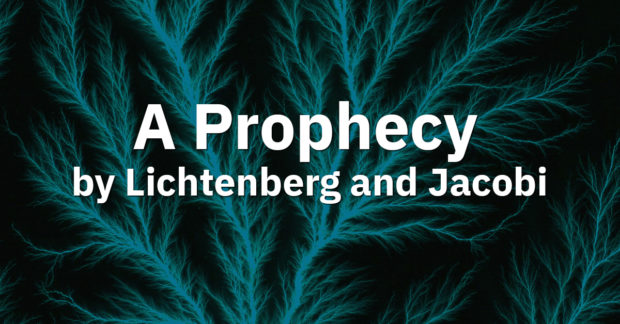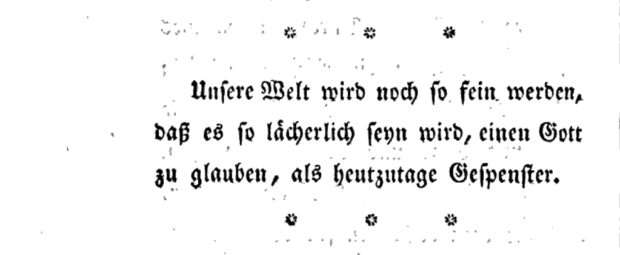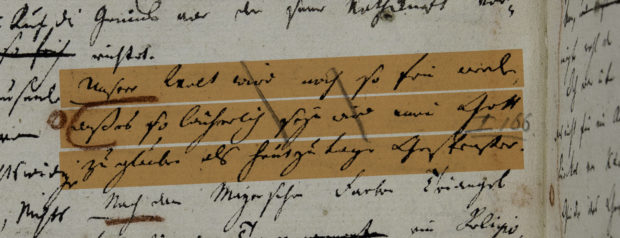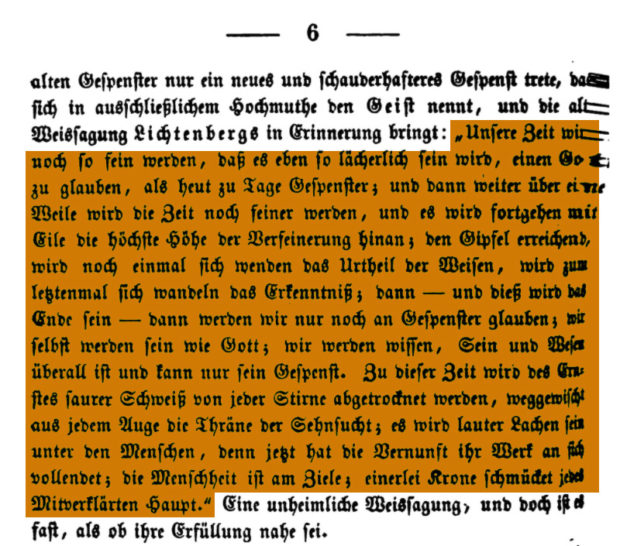An iconographic and text archive related to communication, technology and art.
Our world will grow so refined, that it will be as ludicrous to believe in God, as it is today in ghosts.
Unsere Welt wird noch so fein werden, daß es so lächerlich sein wird einen Gott zu glauben als heutzutage Gespenster.
☛ Georg Christoph Lichtenberg, Vermischte Schriften, Volume 1, ed. Ludwig Christian Lichtenberg and Friedrich Kries, Göttingen: Dieterich, 1800, p. 166. English translation by Bas Geerts.
• • •
This entry documents a “prophecy” attributed to Georg Christoph Lichtenberg (1742-1799), as it was recently quoted (without comments nor references) by Giorgio Agamben on the website of Italian publisher Quodlibet (see “Una profezia di Lichtenberg” from January 20, 2021). Agamben has commented more than once on the art of citation, which he borrows to a significant extent from Benjamin’s own “art of citing without quotation marks”1. Since the whole substance of the “prophecy” being documented below is about faith (Glaube, in German) and its disappearance, it is worth remembering how Agamben also loves to invoke Warburg’s motto, to the effect that “God is in the detail.”2
I am grateful to Bas Geerts for some of the key translations provided in this research, as well as for useful insights and comments. Bas Geerts runs ‘Una voce di Giorgio Agamben’ in het Nederlands, where he provides Dutch translations of Agamben’s interventions on the pandemic.
• • •
In January 20, 2021, Italian philosopher Giorgio Agamben published a short entry on the website Una voce di Giorgio Agamben (hosted by the editor Quodlibet), which he has been using since 2017, but most notably since the start of the COVID pandemic. The entry, titled “Una profezia di Lichtenberg” (“A Prophecy by Lichtenberg”) is atypical as it is not a comment by Agamben himself, but a single quote provided without context, aside from the title. The entry reads as follow (quotation marks in the original):
«Il nostro mondo diventerà così civile che sarà allora ridicolo credere in Dio, come è oggi credere nei fantasmi. Poi, dopo un certo tempo, il mondo diventerà ancora più civile. E continuerà sempre più in fretta il processo che lo porterà al vertice supremo della civiltà. Toccando il culmine, il giudizio degli esperti ancora una volta si capovolgerà e la conoscenza raggiungerà la sua estrema trasformazione. Allora – e questa sarà davvero la fine – crederemo soltanto nei fantasmi»
“Our world will grow so refined, that it will be as ludicrous to believe in God, as it is today in ghosts. And then, after a while, the world will grow even more refined. And this will continue with haste until the highest height of refinement is reached. At the summit, the judgment of the wise will tilt once more, and insight will finally turn. Then – and this will be the end – then we will only believe in ghosts.” (trans. Bas Geerts)
This quote is actually a hybrid quote: it is made of two different quotes, from two different sources. Only the first sentence is from Lichtenberg. The rest of the quote and the idea to call it a “prophecy” are from German philosopher Friedrich Heinrich Jacobi (1743-1819). The idea to bring the two quotes together does not originate in Agamben either, as one can already find instances of such juxtaposition in the 19th century.
In what follows, I first locate and identify Lichtenberg’s aphorism in the various editions of his work, including the original, handwritten manuscripts. Second, I locate and identify the remaining of the quote, as well as the reason why the two different quotes are –and have been for a while– juxtaposed (and possibly confused) together.

The first sentence of the quote used by Agamben is an aphorism by Lichtenberg, first published posthumously in 1800, as part of the first edition of his Vermischte Schriften (Miscellaneous Writings), collected and edited by his brother Ludwig Christian Lichtenberg and Friedrich Kries. It was subsequently republished in later editions of the same Vermischte Schriften, in 1844 (bottom of p. 58) and 1853 (p. 58 again). The screenshot below is how the aphorism appears in the first edition (1800), on page 166:

The aphorism originates from Lichtenberg famous Sudelbücher (“Scrap Books” or “Waste Books”), a series of notebooks in which he recorded reflections, quotes, and various observations, from to the time he was a student to his death (see previously here). At the end of the 19th century, the Sudelbücher were rediscovered by Albert Leitzmann (1867-1950), who published them separately, thus bringing additional fame and attention to Lichtenberg’s work3.
Specifically, the aphorism discussed here comes from Notebook ‘D’ (written between 1773-1775). In Leitzmann’s edition of the Aphorismen, it appears in the second volume, on page 148 (Zweites Heft: 1772-1775, Berlin: B. Behr, 1904)4. Leitzmann is most likely the first editor who introduced the numbering system (which is not used in the Vermischte Schriften, nor in Lichtenberg’s manuscripts, where he instead used a red marker to distinguish between entries). In Leitzmann’s edition, the aphorism is identified as “D 326”:

In 1967, Wolfgang Promies (1935-2002) started working on a complete edition of Lichtenberg’s work, Schriften und Briefe, which was completed in 1992. Wolfgang Promies later co-founded the Lichtenberg Society (Lichtenberg-Gesellschaft), which he chaired for two decades5. In the Schriften und Briefe, Notebook ‘D’ appears in Volume 1. The aphorism can be found on page 282, with the number 329 (so with a slight difference from Leitzmann’s numbering system):


Although the same aphorism is not reproduced in the short selection translated into English by R.J. Hollingdale (The Waste Books, New York: New York Review Books, 1990), it can be found in a French edition published by Jean-Jacques Pauvert in 1966 (translation by Marthe Robert, with a preface by André Breton), where it appears without numerotation:

The aphorism can also be found in Zibaldone segreto, an Italian edition of a selection from the Sudelbücher edited and translated by Francesco Franco Farina (Milan: Edizioni Virgilio, 2014) where it is identified “D 329” (Promies’s numbering system). It is worth noting this Italian translation differs from the one used by Agamben:

Consulting these different editions is useful to eliminate the possibility that Agamben somehow had access to a longer version of the quote. This can be further (and definitely) confirmed by examining Lichtenberg’s handwritten manuscripts of the Sudelbücher, all of which have been digitized, and made available online at the Göttinger Digitalisierungszentrum (except for Notebook ‘G’ and ‘H’, destroyed sometime during the 19th century). The title page for Notebook ‘D’ can been seen here. Lichtenberg’s handwriting is not easy to decipher, but the aphorism can nonetheless be identified on page 152 of the physical notebook (page 38 of the actual Notebook ‘D,’ following Lichtenberg’s own pagination: see a scan of the whole page). Lichtenberg arranged his notes on each page in two columns. The aphorism was inscribed in the second column of the left page, and runs on three lines, highlighted below:

Examining the manuscript shows how Lichtenberg’s used a red marker to distinguish between the various entries. Also worth noting, the pencil note that reads “I 166” in the right margin, most certainly added by an editor after Lichtenberg’s death. It is a reference to page 166 of the first volume of Lichtenberg’s Vermischte Schriften, first published in 1800, where the same aphorism can be found (as shown earlier).
The next step consists in identifying the source for the last part of the quote used by Agamben. An important indication is provided in the massive, 1,500-page volume of annotations produced by Wolfgang Promies for his edition of Lichtenberg’s Schriften und Briefe: Kommentar zu Band I und Band II (Carl Hanser Publisher, 1992). On page 251, for the aphorism D 329, Promies notes: “This remark prompted Friedrich Heinrich Jacobi to write his essay “Ueber eine Weissagung Lichtenbergs” (“About a Prophecy by Lichtenberg”).” Promies also provides a reference to the first publication of Jacobi’s essay (in 1802) and to his location in Jacobi’s complete Werke published in 1816. Below is a screenshot of Promies’s remark:

Jacobi’s essay “Uber eine Weissagung Lichtenbergs” first appeared in Taschenbuch für das Jahr 18026. Various digital copies (scans) of the publication are available online, including one, in colour, hosted at the Bayerische Staatsbibliothek. Jacobi’s essay starts on page 33 of the physical document (or page 3, according to the document own pagination). The first page is reproduced below:

A couple of things are worthy of attention. First, after the opening title “Ueber eine Weissagung Lichtenbergs,” the essay begins immediately with Lichtenberg’s aphorism. Second, the aphorism is clearly identified with quotations marks on the left side of each line where it is printed, a practice introduced in the early 16th century7. Third, the publisher added extra spacing between the letters to further emphasize the quote: a practice known in German as sperrsatz, sperrschrift, or sperren, with which Agamben is familiar8. Fourth, Jacobi actually provides the precise reference for the origin of the quote: Lichtenberg’s Vermischte Schriften, volume 1, page 166 (which corresponds to the reference at the top of the present entry). Fifth, after the aphorism, the quotation marks disappear and normal spacing between the letters resume, indicating that the quote is over and the author (Jacobi) resumes his argument. Moving on the second page of Jacobi’s essay (p. 4), one can see that Jacobi seems to be opening a second quote.

This time however, while the sperren method is used to mark emphasis, quotations marks alongside each line are missing (only an opening and a closing marks are present). No reference are provided either. This is not a quote Jacobi is borrowing from another source: it is his take on how Lichtenberg’s aphorism could be continued. This is confirmed by the text immediately following Lichtenberg’s aphorism (from the beginning of page 3 of the publication to the end of page 4)9:
“Our world will grow so refined, that it will be as ludicrous to believe in God, as it is today in ghosts.”
This is the prophecy of the departed. From the graves this voice rang out in all our ears.
Did you say only this? Didn’t you say the next thing too? – Didn’t you say, or didn’t you want to announce that what comes next, the completion?
So this is the next part of the prophecy.
“And then, after a while, the world will grow even more refined. And this will continue with haste until the highest height of refinement is reached. At the summit, the judgment of the wise will tilt once more, and insight will finally turn. Then – and this will be the end – then we will only believe in ghosts; we ourselves will be like God; we shall understand that when his being and essence is everywhere, he can only be a ghost. About that time, the sour sweat of seriousness will be wiped from every brow, alike the tears of longing from every eye; there will be loud laughter among men, for then reason has completed its work; humanity has achieved its goal; the same crown adorns every glorified head.” (trans. Bas Geerts)
The same essay by Jacobi was later included in his Von den göttlichen Dingen und Ihrer Offenbarung, first published in 1811, where the same typographic settings discussed above were used (see p. 3). It is also the case with the version reproduced in Volume 3 of Jacobi’s Werke published in 1816 (p. 199).
This ultimately, is what Agamben quoted under the title “Una profezia di Lichtenberg”: Lichtenberg’s aphorism (D 326 or D 329, depending on the editions) augmented by a selection from the “next part of the prophecy” created by Jacobi for the purpose of his argument. It is a selection because Agamben did not use all of Jacobi’s new part, but cut short at “… then we will only believe in ghosts,” while leaving aside ”we ourselves will be like God…,” and the rest of the Jacobi’s “extension” of the prophecy.
I was able to locate at least one instance where Lichtenberg’s aphorism and Jacobi’s reply to it were compounded together, stiched as if it was a single quote (i.e., without Jacobi’s comment separating the two, where his announces the “next part” of the prophecy). It appears in a lecture by Swiss theologian Karl Rudolf Hagenbach about the history of Protestantism, collected in the second volume of his History of the Church in the 18th & 19th centuries (Die Kirchengeschichte des 18. und 19. Jahrhunderts aus dem Standpunkte des evangelischen Protestantismus betrachtet), published in 1848. While commenting on the relationship between Christianity and modern culture (how it has become common to assert that the latter outlived the former), Hagenbach evokes “Lichtenberg’s old prophecy” and produce what is actually a compounded quote, made of Lichtenberg’s short aphorism and Jacobi’s reply to it:

Hagenbach’s History of the Church has been translated into English by Rev. John F. Hurst. The second volume was published in 1870 (London: Hodder & Stoughton). There, in the first lecture of this volume, on page 6, the compounded quote can also be located. Below is a transcription (quotation marks in the original):
“Our time are destined to come to such a state of advancement that it will be as ridiculous to believe in God as it now is to believe in ghosts; and then the age will progress to the highest point of refinement. Having reached the pinacle, the opinion of the wise will once more undergo a change, and knowledge will pass through its last transformation. Then will come the end, when we will believe in ghosts alone; we shall become as God, knowing that all material being not only is, but can be, nothing else than a ghost. Then, for the first time, will the sweat of seriousness be dried upon every forehead, and the tears of earnest anticipation will be washed away for all time. Then there will be loud laughing among men; for reason will have perfected its work, humanity will have reached its goal, and a crown will adorn every brow.”
In yet another instance, part of Jacobi’s reply (specifically “Wir selbst werden sein wie Gott”) was simply appended to Lichtenberg’s aphorism in order to create yet another hybrid quote. This hybrid quote was used as a motto for the religious newspaper Allgemeine Kirchen-Zeitung. Below is a screenshot from the edition of Thursday, May 13, 1847 (collected in Volume 26 of Allgemeine Kirchen-Zeitung. Ein Archiv, on pages 625-626):

None of all of the above provides an indication of the source where Agamben found his version of the compounded quote. Since his Italian translation of Lichtenberg’s part differs from the translation provided in the Zibaldone segreto (the Italian edition of a selection of Lichtenberg’s Sudelbücher) it is possible he worked from a German source and produced his own translation. Among many things, Jacobi is often credited to have reinstated Spinoza’s thoughts in philosophical circles, at the turn of the 19th century. In 2009 Quodlibet (which was founded by a group of Agamben’s students, in 1983) published L’abisso dell’unica sostanza. L’immagine di Spinoza nella prima metà dell’Ottocento tedesco, a collection of essays mapping the Spinozist renaissance in Germany in the first half of the 19th century.
• • •
1. Here are some useful references on the topic of citation in Agamben and Benjamin:
- Agamben, Giorgio. The Time That Remains: A Commentary on the Letter to the Romans, trans. Patricia Dailey, Stanford: Stanford University Press, 2005, pp 138-145.
- Méchoulan, Éric. “Érudition et fétichisme.” In La littérature en puissance : Autour de Giorgio Agamben, edited by Guillaume Asselin and Jean-François Bourgeault, Montréal: VLB Editeur, 2006, pp 55–64.
- De la Durantaye, Leland. Giorgio Agamben: A Critical Introduction, Stanford: Stanford University Press, 2009, pp. 145-147.
- Dickinson, Colby. “Citing ‘Whatever’ Authority: The Ethics of Quotation in the Work of Giorgio Agamben.” Educational Philosophy and Theory 46, no. 4 (March 21, 2014), pp. 406–420.
- Martel, James R. “Walter Benjamin’s Black Flashlight: Promoting Misreading over Persuasion to Decenter Textual and Political Authority,” Political Theory 43, no. 5 (October 1, 2015), pp. 575–599.
- Kotsko, Adam, and Carlo Salzani. “Introduction: Agamben as a Reader.” In Agamben’s Philosophical Lineage, edited by Adam Kotsko and Carlo Salzani, Edinburgh: Edinburgh University Press, 2017, pp. 7-9. ↩︎︎
2. See notably Agamben’s Potentialities. Collected Essays in Philosophy (trans. Daniel Heller-Roazen, Stanford: Stanford University Press, 199, pp. 32, 90, 97-98). For more about Warburg’s motto, including a drawing of the motto made by Warburg’s son Max Adolph Warburg, see Davide Stimilli’s essay “Aby Warburg’s Impresa” (2013). In his “Afterword” to Agamben’s The Church and the Kingdom, Leland De La Durantaye suggests that Aby Warburg himself never used the motto in writing, but that it was rather made popular by Warburg’s friend and colleage E. R. Curtius (New York: Seagull Books, 2012, p. 60). A much more thorough examination of the motto –in all its variations– is provided Giovanni Mastroianni in his essay “Il Buon Dio di Aby Warburg” (2000). ↩︎︎
3. For a contextual history of the Sudelbücher, see R.J. Hollingdale introduction to The Waste Books, which offers a limited selection in English translation (available online at the time of writing). See also Werner J. Milch. “Georg Christoph Lichtenberg: On the Occasion of the Two Hundredth Anniversary of His Birth, 9 July 1942.”, The Modern Language Review, vol. 37, no. 3, 1942, pp. 335–355. The German entry on Wikipedia for the Sudelbücher also offers useful information and additional references. ↩︎︎
4. Leitzmann’s edition appeared in the massive collection Deutsche Literaturdenkmale des 18. und 19. Jahrhunderts (German Literary Monuments of the 18th and 19th Centuries). The collection, printed between 1881-1924 (first by Gebr. Henninger and subsequently by B. Behr) counts 151 issues and 85 volumes. Lichtenberg’s aphorism discussed here appears in Volume 131 of the collection. See Wikisource (German) for more information. ↩︎︎
5. For more about Wolfgang Promies, see the obituaries available at the Lichtenberg Society (in German), as well this short Wikipedia entry (also in German)↩︎︎
6. For more contextual information of this publication, see F.H. Jacobi’s “On divine things and their revelation.” A study and translation, by Paolo Livieri, thesis, McGill Univesity, 2019, pp. 15-16.↩︎︎
7. See previously on this blog for more details and additional examples: “The origin and development of the quotation mark” ↩︎︎
8. Agamben discuss the typographical method of sperren in The Time That Remains, specifically in relation to the way Benjamin used it in the Handexamplar of his Theses on the Philosophy of History. Agamben even provides a visual example, reproduced below (trans. Patricia Dailey, Stanford: Stanford University Press, 2005, pp. 138-145). Benjamin himself mentions the method in his essay “What is Epic Theatre?” (Selected Writings, Volume 4, 1938–1940, ed. Howard Eiland and Michael W. Jennings, Cambridge: Harvard University Press, 2003, p. 305). For more about the sperren method, see this Wikipedia entry (in German) and this entry in English on various emphasis methods in typography. ↩︎︎

9.See also George di Giovanni’s comment in his introduction to Jacobi’s Main Philosophical Writings and the Novel Allwill (Montreal: McGill-Queen’s University Press, 1994, p. 153, note 4):
The other was Jacobi’s reaction to an essay by Lichtenberg (published in Part I of his Vermischte Schriften [Göttingen: 1800]), in which it is said, according to Jacobi, that some day “our world will become so fine, that it will be just as laughable to believe in God as it is now to believe in ghosts” (Concerning a Prophecy, p. 3 of the 1811 ed.). Jacobi replied with a prophecy of his own–namely, that “after a little while yet the world will become finer still. And the supreme height in refinement will then swiftly come about. At its peak, the sages’ judgment will reverse itself; fr one final time knowledge will undergo change. Then–and that will be the end–then shall we believe in nothing but ghosts. We shall ourselves be like God. We shall know that being and substance everywhere are, and can only be, ghosts.” The piece was reproduced in the first forty pages of Of Divine Things and Their Revelation (1811), obviously as a pardoy of Schelling, whom Jacobi was accusing of deriving reality from “Nothing.”” ↩︎︎
- By Philippe Theophanidis
- on
- ― Published in Communication
- Tagged: Agamben, faith, ghost, Jacobi, Lichtenberg, religion
